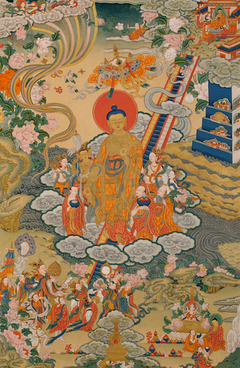In Praise of Devāvatāra
In Praise of Devāvatāra, Site of Buddha's Descent from Heaven[1]
by Jamyang Khyentse Chökyi Lodrö
Oṃ svasti!
Blessed conqueror, Lion of the Śākyas,
I bow in reverence at your feet with their thousand-spoked wheels,
And offer praise to this, the most wondrous of sites,
Where you descended from the realm of the gods.
Ornament of the world, vast and expansive in all directions,
This is a valley of medicinal plants, flowers and forests,
Which rivals in its beauty the celestial playground
Of the three devas Brahmā, Viṣṇu and Śiva.
Heavenly rivers carry flecks of gold and silver,
A great treasury and source of varied gems.
Peacocks perform their delightful dance,
And the Dharma is intoned in attractive voices.
Gods and human beings gather and play as if in a vision —
To see this and to rest here sets the mind at ease,
And causes disturbances in mind and energy to subside.
In this great pleasure grove that delighted the Lord of Sages
Māyādevī, who bore the supreme Kinsman of the Sun,
Through the display of delighting in illusory passion,
Was brought here through the chariot of non-referential love,
And when the glorious lady of summer showed herself,
The voice of Brahmā sounded the great drum of Dharma.
Gods who had slumbered in the sleep of carelessness
Were awakened and light-rays of noble Dharma shone forth.
The ground of seeing the truth was thoroughly tilled,
And fresh shoots of awakening started to grow.
Ema! The devas experienced myriad joys of Dharma,
The likes of which they had not known before.
Cymbals resounded, chiming melodies of praise,
A single divine month passed, and then
The supreme Sage decided to return to Earth.
To herald this descent from heaven
The play of sitars struck up spontaneously,
And upon a staircase of precious lapis lazuli,
He descended in elephantine strides.
The celestial retinues offered gifts on an unimaginable scale,
To fill the sky like specks of dust glittering in a sunbeam
And slowly falling as a wondrous, delightful spectacle
For each and every being to witness and enjoy.
And that Lord of Sages made as a representative
Took seven steps as well, as if in rivalry.[2]
At that time, through the Victorious One's compassion
A precious and blessed stūpa was formed,
As a magnificent field for accumulating merit.
And there were signs of auspiciousness and virtue in abundance.
May the sacred Dharma, which is like healing nectar,
Spoken by the peerless Teacher, the unrivalled Ikṣvāku,
As well as the teachings of those who uphold it,
The assemblies of the ārya saṅgha, flourish and spread!
Thus, through honouring just partially in this way
The deeds of that towering splendour, the great victorious Sage,
With what is no more than a hair-tip of praise,
May we gather entirely the two sacred accumulations!
Throughout our lives, may we and all other beings
Always be accepted by the Buddha, deity of deities,
May we traverse the five paths and ten stages,
And spontaneously accomplish both our own and others' aims!
Thus, in the male Wood Monkey year,[3] while on pilgrimage to the sacred places of the noble land of India, I visited the great site of the descent from heaven, known as Sāṃkāśya. I, Jamyang Chökyi Lodrö, wrote this on the outskirts of that very place. May it become a cause for gaining the ability to sound the music of praise to the sugatas in each and every lifetime! Maṅgalam!
| Translated by Adam Pearcey (with the generous support of the Khyentse Foundation and the kind assistance of Alak Zenkar Rinpoche), 2018.
Bibliography
Tibetan Edition
'jam dbyangs chos kyi blo gros. "lha babs gnas la bstod pa/" in ’jam dbyangs chos kyi blo gros kyi gsung ’bum. 12 vols. Bir: Khyentse Labrang, 2012. W1KG12986 Vol. 10: 361–363
Version: 1.5-20251111
-
One of the eight major pilgrimage places and more commonly known as Sāṃkāśya (Pāli: Saṅkassa). ↩
-
According to some accounts, King Prasenajit had an artist carve an image of the Buddha out of sandalwood, which became the Buddha's representative on earth while he was in the Trāyastriṃśa heaven. The image is said to have greeted the Buddha upon his return. ↩
-
Both available editions of the Tibetan give this date, which corresponds to 1944, but this is certainly an error. In fact, we know from Jamyang Khyentse's diary that the date of this text's composition was in the Fire Monkey, on the sixth day of the 11th Tibetan month, corresponding to 7 Jan 1957. ↩
